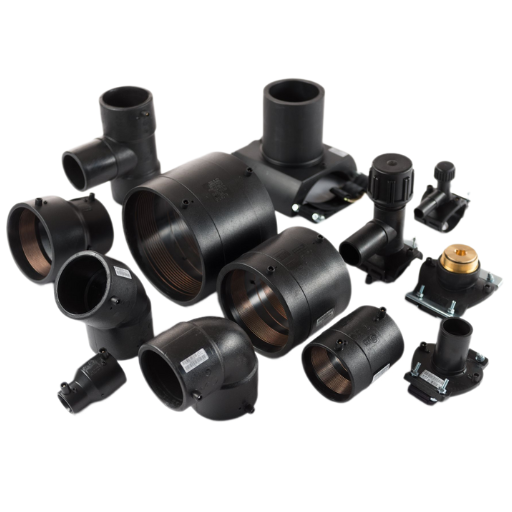High-density polyethylene (HDPE) electrofusion fittings are considered trustworthy for creating secure and efficient pipe connections in pipe and fluid management. This article aims to completely understand HDPE electrofusion fittings by discussing their design, installation procedures, advantages, and typical applications. Whether you have been in this industry for years or just came across it recently, this manual will provide you with all the necessary information to make informed decisions about using HDPE electro-fusion fittings in your projects. Let’s get into the details about this disruptive technology and why it is still preferred for different piping systems.
What are HDPE Electrofusion Fittings?
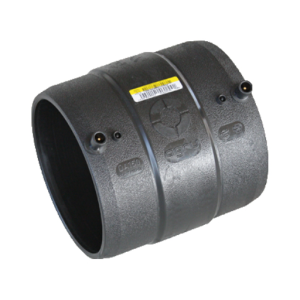
Image source: https://agruamerica.com/
High-density polyethylene (HDPE) electrofusion fittings are specialized joints used in pipes made from high-density polyethylene. These joints work by an electro-fusion process where fitting contains electric heating elements that generate heat through the application of electric current, which, in contact with the HDPE pipe surface, melts both surfaces together to form molecular solid bonds as they cool down. This technique guarantees watertight seals, especially when joints must be long-lasting, corrosive resistant, or flexible enough not to crack easily. Reliability coupled with simple installation has been widely adopted across many industries, such as gas transmission lines and water supply systems, which involve handling fluids at variable pressures or temperatures.
How do electrofusion fittings work?
Electrofusion fittings are plastic that uses electricity to melt and combine two pieces. They work by placing the fitting around the end of one pipe and then heating it until it softens, after which an electrical current is passed through wires embedded within the fitting, causing them to produce heat that melts both surfaces simultaneously, allowing them to bond as they cool off. A good joint should have been created between these two parts by now. This should be ensured by carefulness during the installation process since any mistake made at this stage might compromise its quality or even integrity altogether.
What materials are used in HDPE electrofusion fittings?
In my experience, most HDPE electrofusion fittings I’ve come across were made out of high-density polyethylene (HDPE) because it is known for being resistant to chemicals and extreme weather conditions like UV rays. This makes such pipes durable enough to withstand harsh environmental factors, which other types could not bear up under without getting damaged easily, hence becoming unreliable later on when used frequently over long periods like years or decades at a time, depending on usage rate, among others too numerous mention here. Additionally, some manufacturers add certain additives into their production mixtures to improve various properties, including resistance against sunlight.
Why choose HDPE electrofusion over other methods?
Polyethylene electrofusion has several benefits over conventional joining methods and is widely used. Initially, it leads to a solid and leak-proof connection while resisting environmental forces, lowering failure risks compared to mechanical joints. Second, fitting is easy and quick because no other materials like glue or clamps are necessary, making work more accessible. Lastly, due to their adaptability with different pipe sizes and configurations during complex piping layouts, handling underground installations becomes more flexible, so even in difficult situations, they still provide secure connections.
How to Select the Right Electrofusion Coupler?
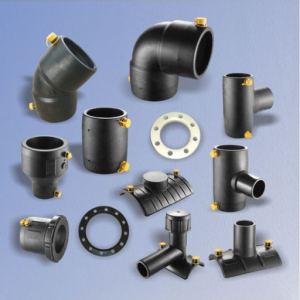
One should consider some essential factors when selecting an appropriate electrofusion coupler. Firstly, you must ensure that it is compatible with your pipes in terms of type and diameter since each coupling device is designed for specific materials or sizes only. Secondly, pressure ratings and temperature limits should be considered to avoid exceeding them during operations within a given system context. Equally important would be thinking about such things as exposure conditions (e.g., UV light) or chemicals, which may affect how well these devices work under different environments. Finally, it would always be advisable to go through the manufacturer’s instructions alongside seeking advice from experts in this field, thus gaining more insights towards ensuring reliable connections for piping systems.
What factors should you consider when choosing a coupler?
Consider these key points when choosing a coupling:
- Material Compatibility: The material of the coupler should match that of the pipe to be connected since failure or leakage may result from using incompatible materials. Polyethylene, polypropylene, and PVC are some common materials.
- Pipe Diameter / Size: A tight-fitting joint is necessary for securing systems; therefore, it is essential to choose a coupler that fits the pipes’ diameter accurately.
- Pressure and Temperature Ratings: You should assess if the pressure (P) and temperature (T) ratings on this part meet or exceed those recommended by system designers based on intended usage environments. This ensures long-term performance reliability under anticipated conditions.
- Environmental Resistance: What type of environment will the coupler be exposed to? Chemicals, UV light, and fluctuations in temperatures, among other factors, might affect its durability; hence, selecting one with resistance capability against such factors can help increase its lifespan.
- Installation Requirements: It is good practice to go through the instructions provided with these parts before purchasing any because some require special tools/procedures, thereby delaying completion time and increasing overall costs incurred during construction projects.
By considering all these aspects, you enable yourself to make choices that will result in successful connections between different sections of your pipeline network.
What is the importance of size range in electrofusion couplers?
The size range is significant for electrofusion couplers, directly affecting how strong joints are made. When choosing a coupler, I ensure its size matches precisely the dimensions of my pipe so that it can fit tightly together and fuse perfectly. Good sizing also allows flexibility during installation where various diameters may need to be joined for specific applications in different projects; however, without proper measurements being taken, weak spots might be created along joints, which eventually leads to leaking, hence failure within systems, thus causing more damage than what could have been initially repaired at lower cost levels otherwise still wrong sizing poses a risk towards making unreliable connections along piping systems because eventually, they will not hold tightly forever until something goes wrong.
How do you identify quality HDPE electrofusion couplers?
I looked at several things to determine whether or not HDPE electrofusion couplers were of good quality. First, if they meet industry standards and have certifications like those from ANSI or EN, the coupler has been tested against some stringent quality guidelines. Second, I research reviews online to establish what kind of reputation different manufacturers have; after all, it’s usually a safe bet to stick with brands that are known for being reliable. Thirdly and lastly but not least notably, in my opinion – considering what materials were used during production is crucial because depending on where these things will be installed (for instance, underground), there may be a need for certain types of polyethylene that resist different environmental factors more than others do.
Installation Process for HDPE Electrofusion Fittings
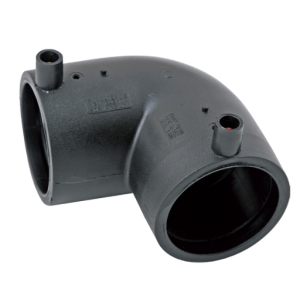
Installing an HDPE electrofusion fitting properly entails following several critical steps for the joint to be solid and functional. First, one should cut pipe ends squarely before aligning them since contaminants like dirt or moisture could interfere with adhesion, thus weakening the connection between the two parts. Secondly – while aligning one piece with another part – make sure that they match perfectly well; otherwise, no matter how hard you try, nothing shall ever stick, thus rendering the whole exercise useless; this is why sometimes people use rubber bands around pipes to hold everything together tightly until work finishes.
Once alignment has been achieved between these two sections, what follows next involves carrying out the fusion process, i.e., heating fitting using an appropriate machine that produces the heat needed to melt material. Setting the parameters necessary to accomplish this according to the manufacturer’s instructions provided somewhere on the packaging, say 250 degrees Celsius, 30 seconds per millimeter thickness, etcetera. After turning on the power supply, wait till the complete cycle finishes, whereby the joint formed cools down completely before doing anything else, as failure to adhere to such requirement might result in a weak bond incapable of holding pressure applied during the test. Therefore, visual integrity installation must be examined to ensure the system is ready to operate without leaks or weak points. This guarantees reliability and contributes to the piping system’s overall strength.
Step-by-step guide to electrofusion welding
- Gather Supplies: First off, make sure you have everything you need. This includes HDPE pipes, electrofusion fittings, a machine, and personal protective equipment (PPE).
- Prepare Pipe Ends: Use a pipe cutter to cut the pipe ends square. Then, deburr them so no sharp points can interfere with joint quality. Clean surfaces well to remove any contaminants.
- Inspect Fitting: Check the electrofusion fitting for any visible defects. Ensure it is suitable for the size and type of pipe used.
- Align Fitting: Place the electrofusion fitting over prepared pipe ends, ensuring tight fitment. Pay attention to aligning them correctly, as this may cause misalignment during the fusion process.
- Connect to Electrofusion Machine: Fix the electrodes of the fitting onto the electrofusion machine. If your device has specific requirements, refer to the manufacturer’s instructions.
- Set Fusion Parameters: Input the proper fusion parameters into the machine, such as temperature and time settings, among others, depending on what they may be. Typically, these are given by the fitting manufacturer.
- Start Heating Cycle: Power up your EF welding unit so that heating can begin. Keep an eye on it, though, because you want everything running within specified limits!
- Cooling Phase: After the conclusion of the recommended heating period indicated by the manufacturer, allow the joint to cool down completely without interfering; in other words, let the bond strengthen well enough.
- Do Final Check: Visual inspection plus pressure testing should be carried out to check for joint integrity. Look out for melt-through or lack of fusion signs, too!
-
Record Process Details: Write down all installation steps taken together with tests conducted during this exercise – such records will come in handy later during maintenance procedures
What are common mistakes during installation, and how can they be avoided?
During the installation of electrofusion, I noticed some common mistakes that can compromise joint strength. The first mistake is poor surface preparation; cleaning the pipe ends and removing any contaminants is essential. I usually ensure that I have wiped both surfaces before starting any work. Misalignment of a fitting can also lead to weak joints; therefore, I always reconfirm whether all items are placed correctly. In addition, failure to follow given fusion parameters may lead to lousy bonding. I followed the manufacturer’s instructions keenly and set my machine right before commencing the heating cycle. These small things save me from making installation mistakes, which could make the tubing system unreliable.
What tools are required for HDPE electrofusion?
To carry out HDPE electrofusion correctly, use these necessary tools;
- Electro Fusion Machine: This equipment supplies heat for joining HDPE composites; it should be adjusted based on fitting specifications.
- Pipe Cutters: Appropriate pipe cutters ought to be employed so that uneven edges do not occur during the cutting process, which might affect proper fusing.
- Scraping Tool: To ensure good fusion, you need a scraping tool to remove oxidation and other impurities from the surface of pipes’ ends.
- Cleaning Wipes or Cloths: These are meant to clean pipe ends thoroughly after scraping has been done before fusion taking place.
- Calibration Device: Continuity needs a calibration device to check whether all electrofusion machine settings match those indicated by the manufacturer.
- Safety Equipment: Technicians should wear personal protective gear such as gloves, goggles, or face shields during installation procedures because these gears protect against injuries that may occur while working.
Working with these tools is easier since they quicken the process and improve quality.
Types of HDPE Electrofusion Fittings
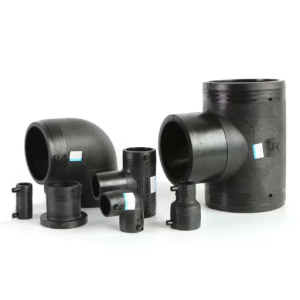
HDPE electrofusion fittings are available in many shapes and sizes, each tailored for specific applications within a pipe system. Here are some common types:
- Couplers: These fittings connect two pipes so that fluids can flow continuously between them without leaking.
- Elbows: Designed to change the flow direction in a pipe system, elbows usually come in 45° or 90° angles.
- Tees: Tees create branches or connections off of main pipelines that redirect the direction of fluid flow.
- Reducers: When pipes with different diameters need to be joined, reducers allow for a gradual transition in cross-sectional area along the joint length.
- Caps: Caps close off ends on lines, which terminates them while also keeping out dirt and other contaminants from entering the system
Each fitting is designed with HDPE (High-Density Polyethylene). Pipe installation quality and reliability performance are prioritized over everything else.
Overview of electrofusion couplers
Electrofusion couplers are a type of specialized fitting used to join together two sections of an HDPE pipe using an electric current during a welding process called “electrofusion.” The procedure involves heating coils embedded within these fittings by passing electrical energy through them until surrounding materials become molten, which results in the creation of a strong joint with no gaps or spaces between the joined parts, thus making it impossible for any liquid medium (gas/liquid) flowing through said union point escape outside while at the same time maintaining physical continuity across the entire assembly. Electrofusion couplings have advantages such as being able to provide leak-free joints, ease of jointing as there is no need for flanges/clamps like other methods do require, and they can accommodate different pipe diameters and wall thicknesses, thus making them versatile enough for various water supply/gas distribution, etc. systems applications. To achieve the best results, one must prepare well by cleaning and scraping ends properly, then sticking strictly according to the manufacturer’s instructions during the fusion stage.
What are electrofusion elbows and their applications?
Electrofusion elbows are specialized fittings used in HDPE piping systems to change the flow direction by joining two pipes at an angle, usually 90 or 45 degrees. They are most commonly employed where it is necessary to direct flow and keep the pipeline intact. What I like about these joints is that they can be connected seamlessly using the same electrofusion welding process, making them very strong with no leaks. As far as my understanding goes, they find significant applications in water treatment plants, irrigation schemes, and gas distribution networks, among others, where space may be limited or a need for complicated routing. Installing correctly by cleaning well and following manufacturer instructions is essential to achieve connections that will last long enough without getting torn apart easily.
Understanding electrofusion reducers
Electrofusion reducers are necessary components for any HDPE pipe system because they enable a smooth transition between different diameters of pipes within such systems. These items allow for easy flow without much turbulence, hence making them suitable for various applications, including but not limited to sewage systems and water supply networks, among many others. They share similar advantages with other electrofusion fittings, like the ability to create joints that do not leak while cutting down on installation time. One must be careful during fusion; ensuring appropriate preparation of surfaces on pipes and accurate observance of heating cycles ensures strong joints that enhance durability and reliability throughout the whole system.
Uses of electrofusion tapping tees and saddles
Tapping tees and saddles for electrofusion are essential to HDPE piping systems, as they enable connections to branches without shutting down the entire pipeline. I have found these fittings extremely useful for creating new service lines in water distribution, natural gas, or telecoms. They provide a sound, non-leaking joint while causing minimal disturbance to surrounding infrastructure. Moreover, the strength and durability of electrofusion connections prevent leaks, thus ensuring the long-term integrity of the system. Tapping Tees & Saddles has allowed me to streamline installs, making them invaluable when working on new builds and repairs.
Maintenance and Troubleshooting for HDPE Electrofusion
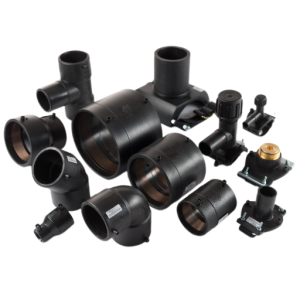
To keep HDPE electro-fusion joints in good condition, frequent inspections must be conducted to detect any signs of weariness, strain, or environmental harm early enough. It’s also significant to ensure that the fusion zone is always kept clean and free from dirt particles since failure can lead to contamination, weakening the joint’s strength. Leaks should be checked for regularly, especially when high pressures are involved, because such may imply one joint has ruptured somewhere along the line. Troubleshooting should start with checking if the correct electro-fusing method was followed during installation, including appropriate heating times after proper surface preparation. When joints get damaged, consult the manufacturer’s instructions on how best to fix or replace fittings so that more problems can be prevented while ensuring your HDPE pipe lasts long enough.
How to maintain HDPE electrofusion fittings?
For effective care of HDPE electrofusion fittings, follow these tips:
- Frequent Check-ups: Routinely examine them to detect wear and tear, leakages, or damages caused by the environment. This will help mitigate against expensive repairs in the future as well as failures within the system.
- Cleaning: Keep the fusion surfaces clean and free from any contaminants. Use proper cleaning agents that will get rid of dirt and other particles before fusing since it is necessary for joint integrity maintenance.
- Monitoring How It Works: Frequently observe pressure levels and flow rates within the system; sudden shifts may indicate inner problems that need immediate attention.
- Record Keeping: Preserve accurate records about installations made, inspections carried out, and repairs done. This aids in following up on performance trends over time vis-à-vis each fitting’s helpful life.
- Manufacturer’s Specifications: Always stick to what manufacturers say about looking after different types of joints used – this ensures long-lastingness and reliability based on established standards of good practice.
When all these are followed through, one can rest assured that their HDPE electrofusion fittings will give optimum service without interfering much with piping operations.
Common issues with electrofusion fittings and solutions
While doing my research, I found out that there are some commonly known problems with electrofusion fittings, and fortunately, I was able to come up with solutions for them as well. One of these issues is poor fusion, which can result from inappropriate treatment of the surface or heating it at the wrong temperatures. To avoid this error, I usually clean all the surfaces intended for fusing very well and strictly follow what the manufacturer says about heat.
The other problem that keeps occurring is leaking around the fitting caused by movements in soil or anything else around it. To deal with this, proper support should be given during installation, together with providing enough anchorage points along its length so that even if there is slight movement after being fixed into place, such will not affect tightness between joints.
Last but not least, failure can be caused by inadequate system pressure monitoring. This can easily be solved by ensuring regular checks on pressure and flow rates, which will help detect any anomaly early before it becomes too late, thus saving time and money. With this approach, where you take action before things worsen and always adhere to industry standards, high-density polyethylene electrofusion fittings can serve their purpose for extended periods without experiencing any difficulties.
When to replace HDPE electrofusion fittings?
There are instances where it is necessary to replace HDPE electrofusion fittings to preserve the pipes’ integrity. Some tell-tale signs that should trigger replacement are visible wear and tear, such as cracks, deformations, or severe corrosion. Moreover, if these joints still leak repetitively or fail occasionally after being correctly serviced and thoroughly checked, they might need to be substituted. Similarly, whenever a review exposes poor fusion, like gaps or unevenness detected during inspection, replacing such connections becomes inevitable lest more problems follow suit. Always check with your supplier on what they recommend for optimal performance based on their knowledge about how long should these things last under certain conditions coupled with other factors surrounding this issue such as maintenance requirements according to manufacturer guidelines and industry best practices; failure to do so may lead into reduced effectiveness therefore frequent monitoring plus timely replacements will help in ensuring continuous operation reliability of any piping system.
Industry Standards and Certifications for HDPE Electrofusion Fittings
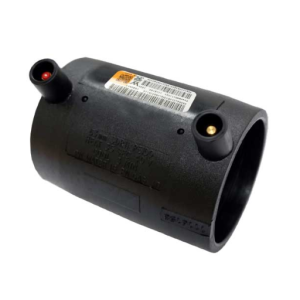
Standards certification for HDPE electrofusion fittings cannot be overlooked due to its significant role in quality assurance, safety enhancement, and product reliability within this market segment. For instance, some localities require adherence to standards like ISO 4427 or ASTM F1056, which specify material properties needed for fabrication besides outlining various testing methods, among others . Furthermore , getting accredited by reputable bodies (such as ANSI / BSI ) offers an added advantage since it gives consumers confidence that suppliers have met specific minimum benchmarks during manufacturing processes. Thus, producers and users must verify whether all necessary certifications were done before installation takes place failure, which could result in legal action against involved parties and noncompliance with local rules, thus putting lives at risk through unnecessary accidents caused by weak links along pipelines. Regularly carrying out audits while following these regulations improves product performance and supports durability and overall system robustness.
What is the role of ASTM in HDPE electrofusion?
The American Society for Testing and Materials (ASTM) is critical in many applications as it establishes standards for HDPE electrofusion fittings. The testing requirements and material properties necessary for their safe and effective use are outlined in ASTM F1056, a standard for electrofusion fittings. Manufacturers can create reliable products by following this standard, which defines criteria such as tensile strength, resistance to creep, and impact resistance. Manufacturers can show that they meet industry benchmarks by following ASTM standards, while users can ensure operational requirements of their piping systems are met by the fittings they choose. More importantly, however, these measures promote safety in addition to a long life span even though these two factors relate closely to performance.
Understanding ISO certifications for electrofusion fittings
ISO certification is also essential to ensure the quality and safety of electro-fusion joints . In my research, I have found ISO 9001, which focuses on quality management systems, to be quite relevant because this assures me that there are efficient ways put in place by the manufacturer so that they can produce consistently high-quality products every time they make them. This also gives confidence in the materials used since ISO 4427 provides specifications about polyethylene pipes and fittings used in water supply systems, hence showing the ability of these items to withstand different conditions. What I know is that if you choose any international standard-compliant e-fusion joint, your installation will meet global benchmarks and become safer and more reliable.
How does PE100 relate to HDPE electrofusion fittings?
PE100 is a high-density polyethylene (HDPE) resin widely used for producing electrofusion fittings. The PE100 mark means this material has better mechanical properties and is designed for high-pressure environments. According to industry sources, PE100 offers excellent durability, environmental stress cracking (ESCR) resistance, and long-term performance compared to lower-quality plastics. If applied with electrofusion fittings, PE100 guarantees strong joints that will not let you down throughout the piping system. Additionally, its compatibility with different installation techniques, such as those involving electricity, can simplify joining parts together, saving time while reducing chances of leakage, hence making it an engineer’s or contractor’s best friend on site.
Reference sources
- Electrofusion Installation and Training Manual
- Electrofusion Installation Procedure Manual
- Generic Electrofusion User Guide for Field Joining of PE Pipe
Related Articles:Why Choose Our HDPE Electrofusion Fittings?



